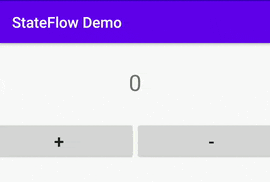In this article, we’ll learn how to use Kotlin Coroutine StateFlow in Android instead of LiveData.
In the recent release of Kotlin coroutines library (1.3.6), you can see there a new class — StateFlow. So what’s this and how it works? Let’s see…
What is StateFlow ?🤷♂️
It’s basically a new primitive for state handling.
It’s designed to eventually replace
ConflatedBroadcastChannelfor state publication scenarios.It is a flow that emits updates to its collectors.
Value can be observed by collecting values from the flow🌊.
Still not getting? Here’s a quick demo to understand —
See this demo program and play with it.
I think now you get it what’s exactly — StateFlow😃. So what’s happening here is whenever we’re updating the value of stateFlow then it emits value to its collectors.
To manage state in Android we generally used Android Arch. component’s LiveData which is lifecycle-aware. We can replace it with StateFlow. Let’s see how to use it with Android. Let’s write some code!
⚡️ Getting Started
Open Android Studio and create a new project. Alternatively, you can simply clone this repository. This is a very simple counter app for demonstrating the use of Kotlin Coroutine’s StateFlow API.
We’ll be using MainViewModel to manage our data of MainActivity.
Now you can compare its implementation using LiveData.
MutableStateFlowhas a setter property for value.We’ve declared an instance of
StateFlowi.e. countState which we’re exposing for activity (It’s a read-only field).*StateFlow*has a property called value by which you can be safely read at any time.
Now let’s implement our MainActivity —
Here, we’ve initialized ViewModel for activity. Now let’s implement the initView() method which will initialize our Counter App UI.
Everything looks cool now! 😃. Let’s observe for count value now to keep track of counting and show it on UI accordingly.
Here’s we have collector which will be executed whenever the value of a countState is updated. We also made it lifecycle-aware as we’ve used it under lifecycleScope. It looks simple, right? That’s it! 😎
Now let’s run this app and see if it’s working.
 Counter app demo
Counter app demo
Ain’t it Sweettttt 😍.
We can implement the same using LiveData too. What’s different then? 🤷♂️
We can use powerful flow operators with StateFlow like combine, zip, etc which can give us more great experience than LiveData. Yes, that’s it.
Final Words:
StateFlowis really easy to handle and implement.Currently, it doesn’t support LiveData’s
onActive()oronInactive()like callbacks but this will be possible onceSharedFlowis officially released 🚀.Its behaviour is the same as
LiveDataalong with more operators and great performance 😎. Then we should consider using it instead of LiveData.
If you found this helpful please give some claps 👏 and share it with everyone.
Sharing is Caring!
Thank You :) 🙏
If you need any help, you can contact me here.

